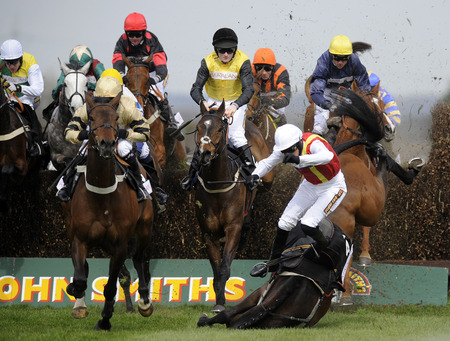Advanced Fiction: WTF Is A Steeplechase?!

Photo Credit: bleacherreport.net
Advanced is the fourth writing class in the Story Workshop. From my first semester, I heard people talking about the Steeplechase project that is central to an Advanced class, and I remember wondering, “What the hell is that?”
Well, let me explain…
A writing Steeplechase derives its name from a horse race on an obstacle course. Jockeys guide their horses over hurdles, puddles and little hills. In a Fiction Steeplechase, the writer guides their story through unexpected twists and turns. But, let’s quit with the writer/jockey metaphors.
In my notes from my Advanced class with Don DeGrazia, I have that your Steeplechase material should be a piece that have already begun writing, but want to expand or push forward. To do the Steeplechase, take that chunk of writing and do the following steps, trying each shift for at least two pages (but going longer if you find it compelling):
1. Start in your original point of view (1st person, 3rd person, etc.) and rewrite the first scene or bit of imagery.
2. Switch POV (from 1st to 3rd or vice versa).
Take note of what the new POV allows you to do as a writer – Can you access characters’ thoughts? Observe something about the character that only an outsider can see?
3. Switch to model form.
A model is where you describe something that typically happens, so a model would use “always” or “usually” a lot. Like, “Every day when Joe got home from school, he would throw his backpack on the couch and turn on the TV.” A model describes routines and is a good way to set up a story because, when the model is broken, conflict is introduced, and the plot really gets rolling.
4. Switch POV to an unlikely character, who you’d never expect to tell the story.
A good way to gain perspective on main characters, and flesh out secondary characters.
5. Shift into a basic form like a story within a story, a folktale, a journal, a letter, a diary entry…
These are story forms that you will experiment with in earlier workshops.
6. Strong Storyteller’s POV.
Write with a strong sense of distance and a compression of time. Write with an awareness of the characters’ POV, motivation and emotion.
7. Switch prose to all dialogue, or a play/script form.
8. Write in a popular media form that is contemporary with events.
For example, TV announcer, radio show, commercial, popular music, stone tablet…
I did a radio ad for a throwback soul concert.
9. Go to a POV that attracts you for some reason.
10. Change your mode of reality.
Go from realism to dreaminess, for example. Change the rules of reality in your story.
11. Do an opposite voice, persona or style from my own.
This could be you emulating a writer who is different from you. If you write like Hemingway, try to write like Faulkner. Or maybe change your writing voice and write in dialect.
12. Use the wisdom that you’ve gained to push the material in a direction that you are attracted to.
Note that each teacher uses a slightly different set of Steeplechase steps, so it will probably not be exactly like this in your Advanced class.
I found the Steeplechase to be a cool exercise, and have even done it with other writing outside of class, when I wanted to expand some material. I wound up with a lot of material in the same setting as my novel, that helped me to get to know my characters. A lot of it worked its way into the book. Other parts will act as seeds for short stories.
Some people really don’t like doing the Steeplechase. Sure, not every step is going to yield something amazing, but if you’re not feeling a certain step, just plow through it. You’ll be done in half an hour, and you’ll only need to turn in a couple steps a week.
A bit of advice: If you’re taking Advanced, it’s around time to start thinking about who you want your thesis advisor to be. The more teachers you’ve taken, then more ideas you’ll have of who you click with. So, I suggest trying to take classes only with grad faculty, and not taking the same teacher more than once. 45 credits seems like a lot, but it flies by!
WEEK LINKS:
Here’s “The 30-Year-Old Virgin (Shooter)” by Kevin Kane on guns.com. Kevin is the managing editor of The Handshake Magazine, and guns.com is a site staffed by Fiction Writing grad student Dan Terrill. And you were worried that writing for money would be boring!
